#Commercial Laundry Washer
Explore tagged Tumblr posts
Text
Introducing Avon Engineering advanced Washer Extractor – a pinnacle of innovation in the realm of laundry technology. This cutting-edge laundry machine seamlessly combines washing and extraction functions, offering an unparalleled blend of efficiency, versatility, and fabric care for a wide range of textiles.

Key Features:
Experience the power of simultaneous cleaning and extraction in a single machine with our Washer Extractor. Furthermore, it ensures thorough and effective washing, followed by swift water removal, streamlining the laundry process.
Tailor each wash to perfection with a variety of wash programs that cater to different fabric types and levels of soiling. Moreover, from delicate materials to heavily soiled items, achieve optimal cleaning results.
Crafted with durability in mind, the Washer Extractor is constructed using premium materials. As a result, its sturdy build ensures longevity and consistent performance, even in high-demand environments. In addition, enhanced usability contributes to a seamless workflow.
Experience Unrivaled Efficiency: Our Washer Extractor revolutionizes laundry by combining washing and extraction functionalities into one comprehensive solution. It ensures pristine cleaning and rapid water removal, delivering efficiency, quality, and fabric care in one package. This advanced machine blends technology, versatility, and durability, guaranteeing exceptional results every cycle. Elevate your laundry experience with a product promising efficiency and excellence. Embrace a new era of laundry care with our state-of-the-art it. Say goodbye to inefficiencies and hello to streamlined workflows and impeccable results. Invest in our Washer Extractor to unlock the full potential of your laundry operations. With its promise of efficiency and excellence, it’s the smart choice for your laundry business or facility.
#Industrial Washer Extractor#Commercial Laundry Washer#High Capacity Washer Extractor#Laundry Equipment Supplier#Heavy Duty Washer Extractor#Energy Efficient Laundry Machine#Washer Extractor Manufacturer#Laundry Automation Solutions#Laundry Facility Equipment#Washer Extractor for Hotels
0 notes
Text
#Best Laundry Service in Dubai#Best Laundry Service Near Me#Dubai Dry Cleaning#Dubai Laundry Service#Ironing Service Dubai#Laundry And Dry Cleaning Dubai#Laundry Dubai#Laundry And Dry Cleaning Services#Laundry Dry Cleaning#Laundry Company Dubai#Laundry Near Me#Laundry Service#Stain Removal Service Duabi#Cloth Washers Dubai#Laundry in Dubai Hills#Laundry Service Dubai#Laundry Care Dubai#Home Laundry Service#Commercial Laundry Service
1 note
·
View note
Text
Starting a Laundromat Alberta Laundry Systems can guide you through starting a laundromat business. Learn about our Coin Laundry Equipment, Financing & Creative Services.
#commercial laundry service companies#wascomat washing machine#encore washers and dryers#industrial laundry service
0 notes
Text
The Top Load Washer: A Compact Powerhouse for Seamless Laundry Operations in Your Business
Equipment that has the ideal balance of dependability and efficiency is necessary to run a successful laundry service. Presenting the top load washer, a timeless favorite in commercial laundry that enhances everyday operations with unmatched convenience and outstanding performance. Come along as we go over the main characteristics and advantages that make the top load washer the best option for your laundromat.
Optimizing Space:
The top load washer is a space-saving marvel in the world of industrial laundry, where every square inch counts. Its small size turns into a tactical advantage, which makes it ideal for companies with limited space. The top load washer allows you to optimize space without sacrificing capacity or performance, whether you're working in a flexible area or tucked away in a charming storefront.
2. Without exertion:
Any successful business revolves around efficiency, and the top load washer fits in perfectly with this philosophy. With its easy-to-use screen and simple controls, this machine makes doing laundry a breeze for your employees. In addition to saving valuable time, the flawless operation ensures dependable and consistent outcomes with each load.
3. Adaptable Performance:
The top load washer is a multipurpose workhorse that offers more than simply size and convenience. This washer offers a range of options, from meeting the tough demands of heavy-duty goods to managing the delicate touch required for delicate materials. The top load washer can expertly handle the various laundry requirements of your company, thanks to its well-designed agitator and configurable settings.
4. Redefining Durability:
Durability is a must in the demanding conditions of a busy laundry. In this regard, the top load washer is impressive because it is made of sturdy materials that can withstand repeated use. Purchasing this small powerhouse is an investment in your company's long-term profitability and dependability.
Elevate Your Laundry Experience with the Top Load Washer
Redefining efficiency in commercial washing, the top load washer is small but powerful, user-friendly but capable. Accept the adaptability, make the most of your available area, and encounter a new level of dependability with this timeless laundry partner.
Visit Nate Laundry to learn more about their selection of cutting-edge equipment and commercial laundry solutions. The top load washer will elevate your business because it combines brilliance and efficiency.
#top load washer#commercial laundry service#commercial laundry machines#commercial laundry equipment
0 notes
Text
Dry Cleaner In Greater Noida West
💯Introducing the best dry cleaning service in Greater Noida! 🌱 Pari Drycleaners guarantees top quality care and attention for your delicate garments. Use our special cleaning and pressing services to keep your clothes looking sharp and feeling soft. We use environmentally friendly processes, so you can trust that we will take good care of your fabrics. 🌳Try out our service and experience the difference yourself! 🛍️
#best dry cleaner in greater noida west#commercial laundry service in greater noida west#carpet dry cleaning in greater noida west#dry cleaner in greater noida west#dry cleaning service in greater noida west#shoe dry cleaning service in greater noida west#steam iron service in greater noida west#sofa dry cleaning in greater noida west#carpet clean near me#carpet cleaning near me#carpet washer near me#carpet washing near me#dry clean carpet near me#dry cleaning carpet near me#carpet dry cleaning near me
0 notes
Text
Prompt 14 - Dull
Wolfstar, February 14, word count 980
Previous part First part
Sirius was twisting his hands together nervously. Remus stood and waited, but his patience was wearing thin.
“So, you know how I told you that I had a shitty flat that I bought with the money my uncle left me?” Remus nodded as he recalled the passing remark Sirius had made shortly after they’d met. “Well, I didn’t sell it like my parents told me to. I found a guy to manage it for me and the commercial space downstairs.” Remus’s brain began putting two and two together. His eyes narrowed as he listened to Sirius finish his confession. “I should have told you when you first brought me here,” Sirius carried on. “But then I didn’t think we’d see each other again, and then I stayed. Then I realised I knew you, or rather I knew of you. You were the man who worked in the laundry room of one of the hotels my family owns and I, and I chickened out. Remus, I am so sorry.” Sirius looked up at him through damp eyelashes, begging him. Remus wasn’t sure what he was begging him for.
Barty sniffed, drawing Remus’s attention to him.
“And what does Barty have to do with all this?” He asked. Sirius’s head dropped, so he was staring at the scuffed floor.
“A year ago, when Reggie died, Barty and I spent a lot of time together sneaking in and out of the penthouse in the Black Star, where you also happened to work. Part of my duties were to go through all the hotels and take stock. This included the staff. Well, whenever I went looking for Remus Lupin, I could never find him. The washers and dryers would all be going, but there was no sign of you. I know better now. But we would joke about the elusive Remus Lupin and wonder if you were actually real or someone claiming two pay cheques. When I told Barty who you were, he thought I was joking. But he let it go, assuming that I’d told you about our little theory. Then I brought him here after you said to, and I’d forgotten that Barty knew about this flat.
So much of the time after Regulus’s death is sort of foggy. I was on autopilot for a lot of the first weeks, and I’d forgotten that Barty had helped me move my things out of here and into storage. These things.” He waved his arm at the collection of furniture he’d moved in, replacing the majority of Remus’s belongings. “He told me I had to tell you. That if you found out further down the line, it would be so much worse. So, I’m telling you now.” Sirius looked up into Remus’s eyes. They were so sad, as though he expected Remus to react poorly. “Not only am I your boss, but I am also your landlord. Remus, I’m so sorry I was too much of a coward to tell you straight away. I was so fucking lonely, and you were so kind and everything with you just felt so easy. I’ve never had any sort of relationship where I felt nothing but joy, and I fucked it up, twice. Remus, I’m so sorry.”
Remus broke eye contact first. He needed a minute. It hurt that Sirius needed Barty to chastise him, so he told Remus the truth. He looked at the sofa, the room divider, and the electronics. Sirius hadn’t gone out and bought them; he’d moved all his old things back in. Remus didn’t know if this was better or worse. It was a lot of information Sirius had just dropped on him. He looked towards the window and realised it was dull. There was almost no light pouring in.
“What the?” He walked over to the window and looked down. All the neon lights on Rufus’s kebab shop were turned off.
“I might have also phoned my guy about the lights and put a restriction on how long Sweeny Kebab can keep them on,” Sirius told him.
“I’m not sure that you can refer to your tenant as Sweeny Kebab, Sirius,” Remus snorted. He turned around and looked at the black-haired man. “Look, I need to know that if we go out separate ways, I’m not going to find myself out on the street.” Sirius’s eyes widened in horror.
“Remus, I’d never do that to you!” Sirius took a step forward, but Remus held up his hand.
“I need it in writing, Sirius. I can’t live with the worry that you might change your mind.” Sirius pulled out his phone and dialled a number.
“Evan, yeah, hi, look, can you pull up the tenant’s agreement? Yeah, for the flat. Excellent. Okay, can you please add that I personally can’t have him evicted? Yeah, well, he’s kind of my boyfriend, and he’s worried… yeah, that. Okay, thanks, Evan.” Sirius hung up. “There, done. You can dump me right now, and you’ll still have a roof over your head.” Remus let out a sigh of relief.
“Good, thank you. Now get out,” Sirius’s mouth dropped open in shock. Remus couldn’t keep his face straight.
“I’m kidding, Sirius. Though you will be buying me breakfast.” He crossed the space between them, pecked him on the cheek and grabbed his keys from the coffee table. “Come on, I feel like a fry-up,” He started down the stairs to the street and could hear Barty howling with laughter at Sirius’s expense. He wouldn’t pretend that this thing he had with Sirius was going from strange to stranger. He really liked Sirius, but at least now he was safe if he needed an out.
He grinned as he stepped out onto the street and saw the dark front of the kebab shop. Finally, he’d be able to go to sleep and wake up without seeing bloody green.
Next part
#wolfstar#wolfstar microfic#wolfstar fic#wolfstar fanfiction#sirius black#remus lupin#sirius orion black#sirius o black#remus john lupin#remus j lupin#sirius x remus#remus x sirius#sirius and remus#remus and sirius#marauders era#harry potter#wolfstar au#barty crouch jr#sirius confesses#he had a lot bottled up#remus just listens#remus needs some insurance#no more neon#Remus plays a trick on sirius#sirius is buying breakfast#well now thats sorted on to the revenge#dull
45 notes
·
View notes
Text
Sunday Steve - Day Ten
Things that would be new or unfamiliar to Steve in the 21st century, either due to the time period he grew up in, or his social-economic status and other such factors.
Day Ten: Laundry — Washer and Dryers
Washing Machine
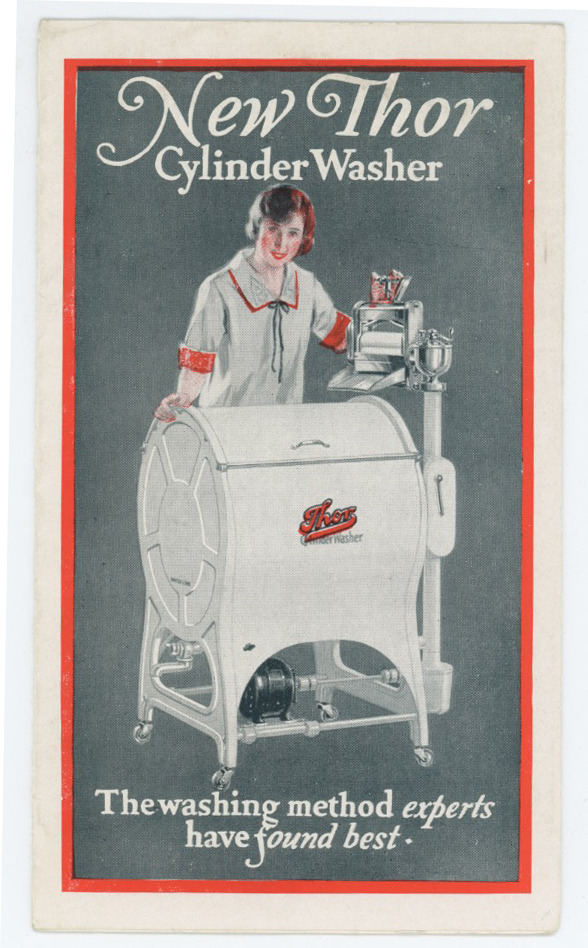
1920s ad for a Thor brand washing machine. One of the first electric washing machines. Note the exposed motor underneath that could shock users when wet. (Imagine Steve associating Thor with washing machines 😆).
Laundry machines have a long history. The first washing machines were invented in the late 1800s. There were mechanical, hand powered machines, consisting of drums full of water and handles to agitate the laundry and turn the rollers to squeeze water from washed clothes.
However, these devices were most common in middle class families. Poor families who could not afford the machines and rich families who did not have to worry about the labour of laundry likely did not have these machines.
Laundry was a laborious task and families who could afford it had hired help to do their laundry or they sent out their laundry to be cleaned and returned.
Here is an account of laundry days in the 1920s for a family who had a scullery. They used a 'washing copper' tub that was built into the floor and had a space for a fire underneath. It is interesting how it describes typical washing without a washing machine, but Steve and Sarah likely lived in a tenement apartment building and did not have these facilities available to them.
We will get into what Sarah probably did when Steve was growing up. But one last laundry innovation to talk about in the 20s was the electric washer. The first electrical washer appeared in the US before the first World War thanks to the invention of the small electric motor (Link).
This blog page gives a good overview of how a domestic electric washing machine worked in 1927. The metal drum was manually filled with water (if you didn't have a hose, lifting and pouring water into the drum was your fate). Pre-prepared soap was added then pre-soaked clothes could be washed. The machines could handle about ten pounds, so clothes had to be regularly transferred in and out. After the wash, clothes were wrung out and put in scalding rinse water to remove soap. Clothes were then wrung out again (maybe rinsed a few more times), starched, and hung to dry. Some families had heated dryer cupboards to hang their clothes.
Domestic washing machines inside the home were not common before the 50s. They were growing in popularity in the 30s, but I doubt Steve every used any type of washing machine in his own home. Depending on how well off you feel the Barneses were they may have had one, but I still feel this wasn't very likely.
In 1920 only 8% of US families owned a washing machine. And by 1941 "only 52% of U.S. families owned or had interior access to an electric washing machine—almost half of families were still hand rubbing or hand cranking laundry or using commercial services" (Link).
Tenement Laundry Days
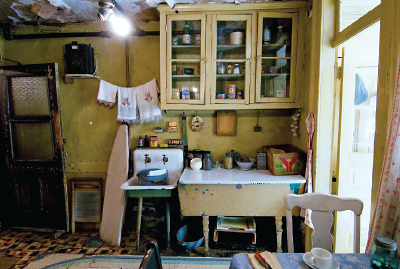
Reproduction of 1928-1935 tenement house.
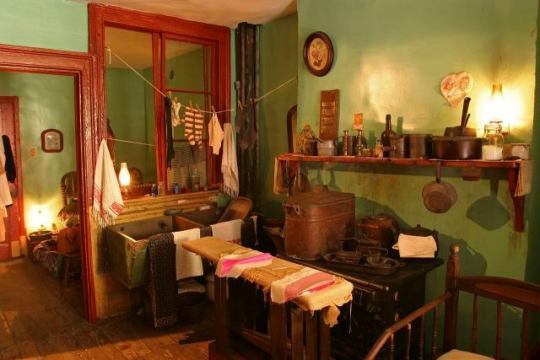
Reproduction of 1890s era tenement apartment.
Wash days were usually on Monday. Sarah probably did these steps: Soaking the laundry, scrubbing, boiling, wringing, rinsing, wringing agin, and finally, hanging to dry. (Link)
In the second picture above a scrub board can be seen in the deep sink. The sink was likely used for soaking, scrubbing and rinsing. Scrub boards were used well into the 20th century.
While indoor plumping for tenements was becoming common in the 20s (especially for toilets), if they didn't have running water Sarah would have to trek up and down flights of stairs to fill her tub from the tap in the yard. (Link) This would most likely only be the case if Steve and Sarah lived in a pre-1905 tenement building as laws about tenements changed around that time. However, many tenements were cold water flats, so water would be boiled on the stove.
In the picture above you can see a large oblong metal tub on the stove. This is likely what was used for boiling.
After soaking (usually started Sunday night) clothes that were still soiled would be scrubbed, then the laundry was boiled. Clothes were boiled in water for an hour and stirred with a rod or wooden stick. They would then be removed with a fork or a rod, wrung out, rinsed (to remove soap) and wrung out again.
If Sarah (or Winifred) was able to afford it she may have a mangle to squeeze the water from washed clothes ($5.95-8.00 for a basic one in 1920). These two wooden rollers were dangerous because women could get their fingers or hair caught in them. They also sometimes damaged or broke off buttons. If she didn't have one, she'd wring them out by hand.
The spin cycle was developed to wring out clothes, and some electric washers had this feature going into the 30s. (Link)
Once wrung out, the clothes were hung to dry. In the winter clothes could be hung in front of the fireplace or stove (on a clothes horse for those who had one) if there was space, but they could also be hung outside to freeze and brought in before nightfall.
Tenement buildings commonly had clotheslines strung between buildings. "The advantage of living on a low floor (with fewer flights of stairs to climb) became a disadvantage on wash day, because when hanging your laundry out to dry, ‘someone else might put out a red wash or a blue wash over it, and it drips down and makes you do your wash all over again." (Link)
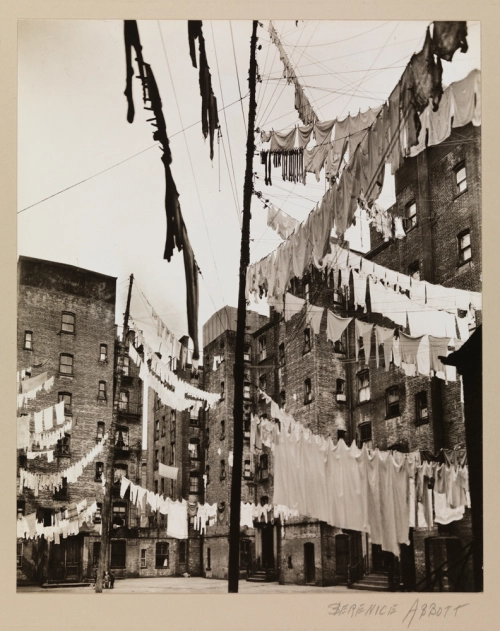
Berenice Abbott (1898-1991). Court of the First Model Tenements in New York City. March 16, 1936. Museum of the City of New York. (Link, many other examples of tenement clotheslines here. I think this is multiple days of laundry lines in one picture).
Abbott documented this space as a communal laundry line: ropes with pulleys led from apartments to five-story poles imbedded in concrete. Abbott made two exposures, with the laundry and poles forming different abstract configurations. She later recalled that winter day the laundry frozen stiff and the children huddled together, too cold to move.
If you didn't have a clothesline near your window you could dry your clothes on the roof. This required climbing more stairs and keeping an eye out for thieves. (Link)
Tuesdays were ironing days. There were electric irons in the 20s but people also still used multiple irons that had to be heated on the stove. Clothes needed to be damp and sprinkled with water while ironing. That is until steam irons were introduced in the 30s. (Link)
However:
What did Steve do after Sarah died? The same thing the Rogers would have done if Sarah had no time to do laundry, which is likely because she worked full time and laundry was an long chore. If Sarah did do her own laundry as well as worked, she would have worked very long hours trying to stay on top of everything.
For those who couldn't do laundry they would send out their laundry. The peak of the commercial laundry industry was in the 1920s. Many laundries were owned by Chinese immigrants and these laundries catered to single men. (Link) These laundries were cheaper than white-owned steam laundries, which generally catered to large institutions like hotels and hospitals, although they advertised to women as well. Here is a picture of a large commercial laundry.
Sending out laundry may have been a necessary expense on Sarah and Steve's part that they had to budget for. This recounting of a Chinese laundry has the clothes dried and ironed by the workers.
Women, especially black women, took laundry into their home. It is possible Sarah and Steve sent out their laundry to washerwomen, perhaps even one who lived in their own tenement. (Link)
If Sarah did not have the time, nor could afford to send out laundry (especially in the 30s), Steve may have had to deal with the shame of going to school in dirty clothes. Cleanliness was a point of pride and I'm certain Sarah would have made every effort to keep him clean but it may not have always been possible.
Laundry soap
Here is what was most typically used as laundry soap. It was also common, especially for rural families, to make their own soap out of lye and grate or cut up that as laundry soap. (Link)
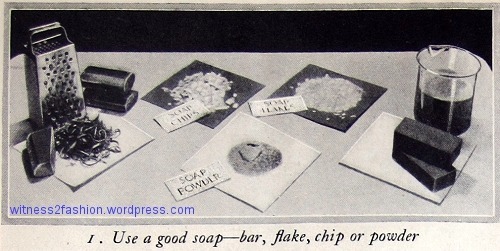
(Link) Laundry soap options in 1927. They included purchasing flakes, chips, or powder; liquifying your soap ahead of time (right); and (left) grating your own laundry soap from a bar. Fels Naptha soap, which came in a big bar, was rubbed on difficult stains and rings around the collar.
Laundromats
The first laundromat or 'washateria' was opened in Texas in 1934. (Link) Laundromats grew in popularity and spread across the country. These early laundromats had rentable electric washing machines like the ones already mentioned in this post. Clothes were taken home damp to be ironed.
In the 40s the name laundromat became common to describe self-serve laundry. This name actually comes from a brand of automatic washing machine. (Link) Laundromats helps familiarize consumers with washing machines and grow their trust in them, thus ushering in the domestic washing machine age in the 50s and 60s and the decline of commercial laundry services.
Steve may have used a washateria or laundromat in the late 30s or early 40s but the machines would be different. They may have looked something like this:
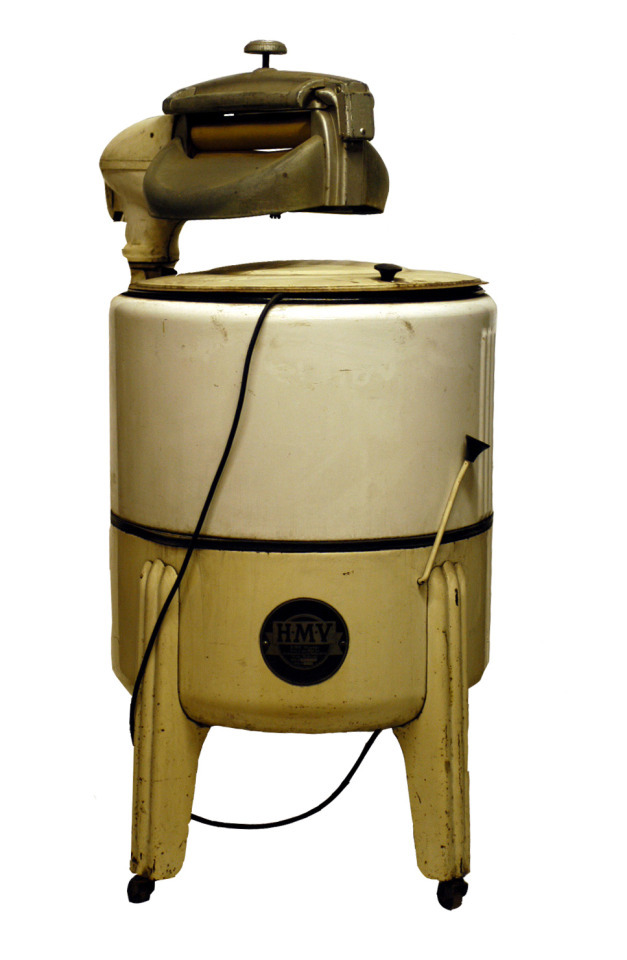
Toploading washing machine bought in 1939 (Link) It has a motorized mangle.
This blog also has many 1940s ads to show other styles of washing machines. I think our modern washings machines would be somewhat recognizable if Steve saw these ads, but in general washing machines now look very different from the ones he probably saw.
Dryers
If one didn't hang their clothes to dry they were probably wealthy enough to have air dryers which became available in the early 1920s. These were rooms or cupboards. "These dryers could be powered by electricity, gas, or kerosene. In a good dryer, heated air circulated around the clothing so that the clothes did not bake and yellow. The hot air was pulled out of the cabinet and up a chimney" (Link).
Richer folks could also have their clothes dry in sunlit or steam-heated rooms at the top of their mansion or townhouse. (Link).
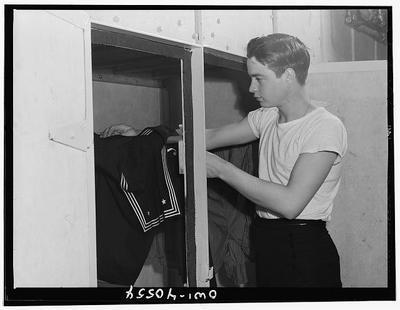
A sailor getting a uniform out of a clothes dryer in 1943 (link)
The first electric dryer was manufactured in 1938. (Link) Here's a picture of a 1940s dryer, it looks a bit like an oven.
Automatic dryers were slower to arrive. Launderettes had dryers after the war and this helped facilitate the arrival of dryers in the home.
Before dryers became common in laundromats clothes were taken back damp and ironed. This was more or less ideal anyways since clothes needed to be damp to be ironed if you didn't have a steam iron (which was still a luxury).
Dryers would be very new or completely foreign for Steve. I doubt he used one.
Army Laundry Days
This post is already long (I know), so quick coverage of what I found here.
Army training camps had laundries. The army developed laundry trucks (Quarter Master Laundry Units) to service medical units and troops in the field.
When the trucks couldn't keep up with the front (although they did their best) soldiers made arrangements with local laundries or cleaned their clothes themselves.
Clothing exchange was sometime done instead of cleaning and returning the same clothes to speed up the process. This was done most often with front line troops, often in conjunction with showers.
Steve specialised uniform (really, all of the commandos' uniforms) would probably complicate this process which is really interesting to think about. This wash trucks wouldn't be able to just bring standard uniforms to switch out since they were all wearing different uniforms from different armies. If it could be arranged beforehand they might be able to bring a new uniform for Steve, but I wonder if he wore regular fatigues most of the time and only switched into his Captain America suit during active missions to make things easier.
The mobile laundries also organized clothing repair.
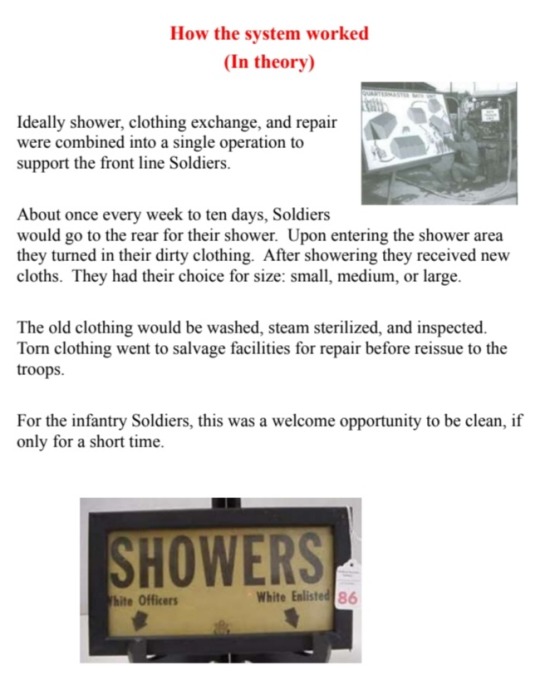
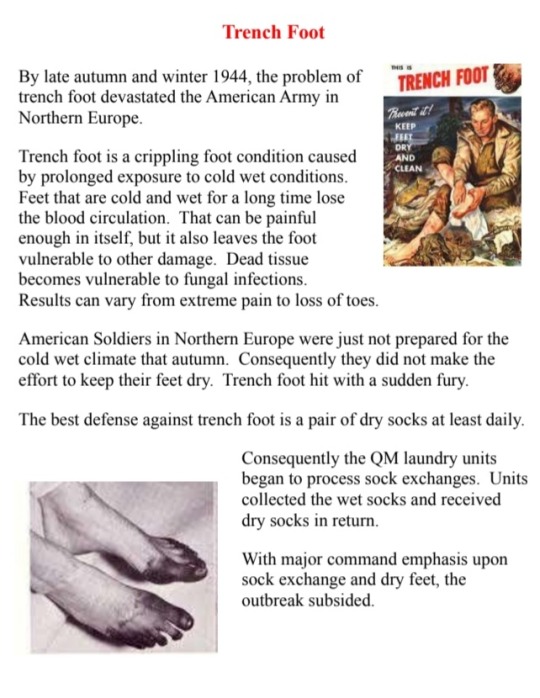
This post got really long! I didn't get into the detailed steps of laundry before modern technologies really took off. But needless to say there's still a lot that could be said.
I have a housekeeping book from 1952 that goes into detail how to wash clothes. If anyone is interested in a post about that, you can let me know. I also have a catalogue reproduction showing laundry machines and prices from the early 20th century if anyone is interested,
Sunday Steve Masterpost
#sunday steve#steve rogers#laundry#washing machines#dryers#early 20th century#american history#history#Sarah rogers#washing clothes#laundromat#steve rogers meta#meta
48 notes
·
View notes
Note
Fave cass headcanon? (hiii I love your vibes)
HII!! I love your vibes too <33
Ooh my fave Cass headcanon is that she doesn’t know what a washer & dryer are for the longest time, I mean she never really questioned how her clothes and place got clean while she lived in Blüdhaven, so she thinks it’s just a thing that happens. The first time she really sees one was probably when she passed a laundry mat and observed the place/people, that or its mentioned during a commercial/tv show.
11 notes
·
View notes
Text
Everything is moved but not every thing is in its place. She's got old bones and fresh paint our new apartment. The ceilings are of varied heights and my girl, who started life in a 1.5 floor Cape Cod, is enchanted by the angles.
We've taken a step further from our Great Lake and ended smack dab in the middle of several average sized lakes. In fact, our new town, which has half the population of our previous town, has a distinct summer resort vibe. We're only one block from our starter lake. But as with most prime real estate, we need to walk further for public access.
There's a Moose Lodge in town. The sign says it's "The Family Fraternity". I'm a believer since my niece met her third (and for all appearances) final husband there. I'm sure I'll walk over some Friday night and check it out.
Last night I caught up on three weeks' laundry. This place came at the rock bottom monthly rent of $1,450. (Believe me I looked. In this economy I'm winning.) There is nary a washer nor dryer, here. So we hauled about 150 pounds of dirty clothes, etc to the laundromat. But not the closest laundromat. Our town's only laundromat is rated 2 stars. My daughter is an educated consumer and found a 5 star facility only 14 minutes away.
I must say, the 5 stars are deserved. We pulled up to the strip mall and there it was nestled between a sit-down Mexican restaurant and an old school music store. Location, location, location.
Commercial washers hold 60 pounds of wash each and only take 20 minutes. They end their cycle by spinning fast enough for take-off so the dryers run at 8 minute intervals. We were in and out pretty quick especially considering the massive quantity of washing to be done.
After the girl's first trip to the car she came in all excited and insisted I step outside. "You're gonna like this." were her exact words. I was imagining free tacos, but it was even better. Next door, in the wood paneled music store, there were eight or nine geezers (I use the term affectionately) jamming on their guitars and bass. The windows rattled and the sidewalk was thumping. I do love some live music. What a fantastic surprise.
I refrained from going in with my two dollars cash and asking where the hat was but I still may call and see if this is a weekly or monthly event so I know when to schedule my laundry going forward. Dinner, chores and entertainment. What more could a girl want?
Love and tacos,
Dagney
5 notes
·
View notes
Text
Argh! The washing machine isn't fixed yet. Nate the repairman showed up exactly on time. Initially the company told me "Between 8 AM and 4 PM." Later that was adjusted to 8:20 AM. Whew.
The repair is covered under warranty, but Nate didn't have the part. He'll be back Thursday. I really miss my working washing machine.
Laundry, which I tend to do one small load per day, has been stacking up like I-494 during rush hour. Or even like I-494 on a Sunday morning (and no way are that many people on the way to church).
After Nate departed I went to a nearby laundromat to run a few loads though the heavy-duty commercial machines. I think I might want one of those for my next washer. The coin box would be a good savings account.
Luckily my dryer still works. I brought the clean, wet clothes home where I can dry them for almost free. The sad, broken washer sat empty, with no lights for the settings lit up, as I focused my attention on the dryer. It felt like taking just one dog on a walk while the others stayed inside, forlornly watching me through the front window.
Just before I left for the laundromat the kitchen sink backed up. Oh dear. It's bad enough when one thing is wrong with the house. Now two!?!?
I went nuclear and poured a ton of drain cleaning gel in the sink. It could sit for an hour while I was gone, not just the prescribed 15 minutes. When I got home the sink was empty. I ran a lot of hot water through that drain to make sure it had not just slowly drained. The drain could handle as much water at the faucet could supply. Back to only one thing not working in the house, besides me who isn't working all week.
Again I'm making chicken soup with whatever leftovers I have in the house. Earlier I Googled "What else can I add to homemade chicken soup?" I'm going with a few of the suggestions: ginger and small amounts of turmeric and curry.
It smells wonderful. I started eating it well before usual lunchtime. The extra spices work well. Next time I'll go even stronger.
When I go to Target later, to restock drain clearing gel and listen to the soothing sounds of the always available crying children, I won't be hungry shopping.
Get this: In the last two weeks there have been two murders within walking distance of my preferred Target store, in a city that almost never sees any homicides at all. I'd better keep my eyes open!
44 notes
·
View notes
Text
things that some trucking companies list as 'perks' to potential new drivers that are really just a given, or at least should be:
-a driver's lounge. what?? you mean at the company yard there is a place to.. sit down? whaaaaaat
-laundry. you mean your company yard provides 1-2 washer and dryer machines to the drivers that basically live in their trucks that belong to your company?? whhaaaat
addendum: im not joking, these mega-carriers that will have upwards of 40 tractors parked in a company yard overnight at once will usually not have more than 2 sets of laundry machines. it's ridiculous. in case you're wondering, the other place to do laundry on the road is at commercial truck stops, where they charge high prices and the machines don't work and it's a great time)
-weekly or bi-weekly pay. yeah that's how jobs usually work my guy. we're not going on the honor system here
-24/7 dispatch. whaat?? you mean if someone is making a delivery at 2am and they run into a problem or need an extra fuel stop, there will be someone available to call?? ridiculous. that sort of thing would never happen literally all the time. nobody has ever gotten into an accident and had to talk to the safety dept after business hours. unheard of
-electronic logs. any company that's not basically just one owner/operator who is using paper logs anymore is highly suspect, and is probably trying to coerce employees into driving unsafe/illegal hours
-fuel card. yeah obviously. if you are a company driver, or an owner/operator and paying your own fuel costs, it is extremely common for the company to provide a fuel card for at least one truck stop chain. they are going to do it to get discounts for their company drivers anyway, they should also let the owner/ops benefit
-flexible home time. you mean i can go home specifically in time for my niece's bat mitzvah or my grandmother's funeral?? how kind of you
-higher pay for specialized driving such as triples or heavy haul. obviously more difficult. requires more training and endorsements. and worse routing if there are roads you can't access. for example, an oversized load might not be able to fit under certain bridges, and some national parks don't allow hazmat tankers in case of spillage
-sufficient weekly or monthly miles rolling. people aren't signing up to drive in order to.. Not
ACTUAL perks to look for:
-rider/passenger policy (your partner or kid can be in the truck with you)
-pet policy (you can have a little friendo living in the truck)
-general pet policy, instead of like 'one pet allowed, and it has to be a dog under 40lbs and there's breed restrictions' bullshit (we have met some massive trucker puppies. depending on the individual dog, a large size dog can do fine in a truck)
-no pet deposit. like at an apartment where you have to pay a fee for the pet to stay there
-no slip seating, meaning you have the same truck for like a year at a time. generally you can also ask to have the tractor detailed/cleaned when you swap to another tractor that's not brand new. slip seating doesn't allow you to settle, in or decorate, and you often have to put up with smoke smell or a huge mess or whatever
-extra pay for things like extra stops on the same truckload, tarping [for flatbeds], passed dot inspections, detention hours, etc
-exclusively no touch freight or exclusively drop and hook freight. this is specifically for over-the-road, dedicated, or regional drivers though
-for lighter-than-truckload drivers, having a person to unload the truck, instead of having to drive and also ruin your spine and knees all in the same eventful day
-extra pay for driving in some urban areas, driving internationally, and having your hazmat endorsement
6 notes
·
View notes
Text
Best washing Machine For Laundry Use
When it comes to selecting the best washing machine for your laundry needs, Avon Engineering washing machines stand out as a top choice. Here's why:

Experience hassle-free laundry days with our Washing Machine’s intelligent features. Moreover, from automated water levels to precise wash cycles, it ensures optimal cleaning while conserving resources.
Trust in the gentle touch of our machine. Additionally, with carefully crafted wash programs and drum movement, it ensures your clothes are treated with care, preserving their quality and extending their lifespan.
Say goodbye to stubborn stains. Furthermore, our Washing Machine boasts advanced stain removal technology, effectively targeting and eliminating even the toughest marks, giving your clothes a fresh lease on life.
We understand the importance of sustainability. Consequently, our machine is designed to optimize energy consumption without compromising on performance, reducing your environmental footprint and utility bills.
Whether you have a small load or a hefty batch, our Washing Machine’s generous capacity can handle it all. Regardless, there’s no need to compromise on laundry volume or quality.
Simplifying laundry chores, our machine features an intuitive interface. As a result, easily select wash cycles, customize settings, and monitor progress with just a few taps.
Bid farewell to noisy laundry sessions. In addition, our machine operates quietly.
Crafted with precision engineering and quality materials, our Washing Machine is built to withstand the rigors of frequent use. Therefore, it’s a reliable companion for years to come.
#Washing machine#Laundry machine#Clothes washer#Washer#Front-loading washing machine#Top-loading washing machine#Energy-efficient washing machine#High-capacity washing machine#Smart washing machine#Quiet washing machine#Compact washing machine#Stainless steel drum washing machine#Washing machine with steam function#Washing machine with inverter motor#Avon Engineering washing machine#Energy Star washing machine#Water-efficient washing machine#Gentle on clothes washing machine#Quick wash cycle washing machine#Delay start washing machine#Child lock washing machine#Automatic detergent dispenser washing machine#Adjustable spin speed washing machine#Wi-Fi enabled washing machine#Smartphone-controlled washing machine#All-in-one washer dryer combo#Best washing machine for large families#Best washing machine for small apartments#Commercial washing machine for businesses#Industrial washing machine for laundromats
1 note
·
View note
Text
Day 1 NaClYoHo
Today's goal is to un-decorate from Halloween!
This is going to involve:
Washing Halloween dishware Done!
Washing Halloween laundry--in progress, also found a load of laundry I forgot was already in the washer, whoops!
Finding/wrapping/packing decor items--in progress
Fitting everything back in the storage tote--in progress
A bonus for this item, since it's closely related, is putting out the last of the Thanksgiving decorations.
I plan to combine this with watching Life Below Zero (my dad and I watched the show as a bonding activity; he died last year). I forgot that I had set the series to record and a bunch of new episodes are sitting in my DVR. So during commercial breaks or between episodes or generally when I feel like pausing, I get up and work on un-decorating. And when I start feeling tired or overwhelmed, I sit down and start watching again. I'm hoping there will be enough "natural" reasons to want to get up or pause the show that I won't get sucked down into inertia again.
Here's a picture of one of my Halloween items! I collect these nutcrackers and get a new one each year. Gonna have to get a new shoe box for them soon.

14 notes
·
View notes
Text
Commercial Laundry Repair Services At Alberta Laundry Systems, we support your business long after you have purchased your commercial laundry equipment. We have years of experience serving the laundry industry across Alberta, the Northwest Territories, western Saskatchewan, and eastern British Columbia. So, when it comes to repairs and replacement parts, we’ve got you covered.
0 notes
Text
The Lazy Song
Do not confuse this with last year's 'Down by the Lazy River'. While they might share a general theme (just how lazy people are) the first one was about marijuana delivery to your home. This one is about capitalism, or how I can make money off of just how lazy people have become.
This one started with a TV commercial. Did you know that people living in homes and have their own washer/dryer combos, are now using an app to call in a service for people to do your laundry for you? I kid you not. I recognize doing laundry is a complicated process with the whole separating of the whites from the colors (not as racist as it sounds in my head) and then having to put the washed clothes into a dryer. It must be a real brain buster for some people.
This got me thinking: 'What .com business can I start up to make some money on the younger generation's aversion to doing anything in the way of manual labor around the house?'
There is already fast food delivery (don't get me started again on that one) groceries (which is good for the elderly and disabled) booze and weed so there doesn't seem to be much else out there to make a buck off of. Or is there? I have a few ideas that I recently had copy rights secured on just in case one of you jumps the gun and tries to get to market before I do. My brain still works but sometimes my body doesn't cooperate so much anymore.
'Squabbles' . Put this app on your phone and then the next time your spouse is in a feisty mood and wants to argue with you press a button and within minutes a person shows up to fight with her. (oops, or him) You can then get back to watching TV while they hash it out for hours in the next room. Next level will be that you both have the app, you are both in a mood, and you bring in two people to fight while you go to a movie.
'BMW'. Not the car as you might think. This one stands for bowel movement wiper. What is lazier than not wanting to wipe your own butt? Bring in a professional and prevent those nasty stains in your gitch.
'Guests'. Do you want to have people over but your friends are too lazy to make the drive? Bring in some substitutes. The beauty here is that you can get them to leave whenever you want. They can also go to parties you do not feel like going to because you want to watch the big game live. Send someone in your place and have them take notes. They also provide Tupperware so they can bring you leftovers making sure you don't miss out.
"Steps'. Not the app you are accustomed to. It doesn't count your steps. Your spouse wants to go for a walk in the woods on a fine summer day but you don't want to? Someone will come to your place to walk with them. Also can be used for shopping buddies. You just have to designate whether or not it will involve carrying pkgs.
'Bath Buddy.' Need a description? They will scrub those hard to get at places for you. All you have to do is lie there (or stand there with the companion app Shower Buddy) and let them do all the work.
There are probably more but this is enough to make me rich beyond my wildest dreams. Maybe an app that gets people to help spend my money, although there are scammers out there just waiting to do this.
THOUGHT OF THE WEEK: Convenience is nice but there is a joy in doing things for yourself that just can't be beat.
2 notes
·
View notes
Text
Industrial Washing Machine Manufacturers

If you need trustworthy industrial washing machine manufacturers, you’ve found the right place. Our heavy duty washing machines for industries are built to handle large volumes of laundry quickly and efficiently. Unlike regular home washers, these high capacity industrial washing machines are designed to work nonstop in demanding environments like hospitals, hotels, and factories. As leading industrial washing machine suppliers, we ensure every machine meets strict quality standards for durability and performance.
Our range includes automatic industrial washing machines that simplify operations and save time. Whether you require an industrial washing machine for hospitals and hotels or customized solutions, our expert team can assist you. With reliable products and excellent after-sales support, we are your trusted industrial laundry machine manufacturer committed to helping your business run smoothly.
What Are Industrial Washing Machines?
Industrial washing machines are large, strong machines made to clean a lot of clothes, linens, or fabrics at once. They are also called heavy duty washing machines for industries because they can handle tough jobs and last for a long time. Many are automatic industrial washing machines, which means they do their job with little help, saving time and effort.
Benefits of Industrial Washing Machines
Using high capacity industrial washing machines brings many benefits:
They wash more clothes in less time, saving money.
They use water and energy efficiently.
They have strong parts that last longer.
They help maintain cleanliness and hygiene, especially in hospitals and hotels.
Industries That Use Industrial Washing Machines
Several industries need these machines, such as:
Hospitals and clinics, which require very clean linens and uniforms.
Hotels and resorts, which wash large amounts of bedding and towels daily.
Factories and manufacturing units where workers wear uniforms.
Commercial laundries that wash clothes for many clients.
Key Factors to Consider When Choosing an Industrial Washing Machine Manufacturer
When selecting a manufacturer, it is important to check:
Quality and durability of machines.
Whether they offer industrial washing machine suppliers with good customer support.
Options for machine size and capacity.
If they provide industrial washing machine manufacturers with after-sales service to help with repairs and maintenance.
Compliance with safety and environmental standards.
Why Choose [Your Company Name] as Your Industrial Washing Machine Manufacturer?
At [Your Company Name], we pride ourselves as trusted industrial laundry machine manufacturers. Our machines are designed for durability and efficiency. We offer industrial washing machines for hospitals and hotels, meeting the highest hygiene standards. Our team provides excellent after-sales support and industrial laundry system installation services to ensure your machines run smoothly from day one.
Packaging, Delivery, and Installation Services
We carefully package all machines to avoid damage during transport. Our team ensures timely delivery and offers expert installation. We also provide training so your staff can operate the machines safely and efficiently.
How to Get a Quote or Place an Order
Contact us through phone, email, or our website to request a quote. Please share your requirements like machine capacity, industry type, and any special features you need. Our team will respond quickly with the best options tailored for your business.
Conclusion
Choosing the right industrial washing machine manufacturers can improve your laundry operations greatly. Whether you need heavy duty washing machines for industries or efficient machines for hospitals and hotels, we offer trusted products and services. Reach out to us today to find the perfect industrial washing machine for your business.
#industrial washing machine#industrial washing machine manufacturers#heavy duty washing machines#automatic industrial washing machines#high capacity industrial washing machines
1 note
·
View note